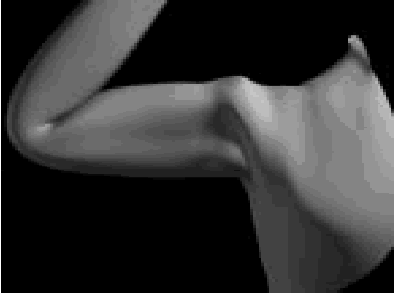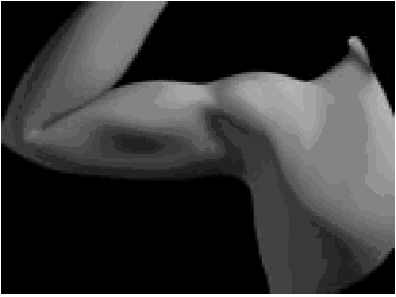 2. Kinematic Approach 2. Kinematic Approach
The kinematic approach to muscle deformation is when no underlying muscle system is used to affect the
surface geometry. It is "faking" the more accurate
effects of a physically based system.

 Skeleton-Subspace Deformation
"Enveloping" Skeleton-Subspace Deformation
"Enveloping"
The most commonly used deformation algorithm has various names, such as “enveloping”, “skinning”, “skeleton
subspace deformation (SSD)” or "linear blend
skinning". This is the standard, and most commonly used method of deformation in off-the-shelf
packages such as Softimage XSI and Maya.
There is a good description of the technique in the Siggraph paper
"Building Efficient, Accurate Character Skins from Examples"
"This technique assigns a set of influencing joints and blending weights to each vertex in the
character. The skin is computed by transforming each vertex by a
weighted combination of the joints' local coordinate frames...While fast to evaluate and compact in
memory, this method is notorious not only for its authoring
difficulty, but also for its undesirable deformation artifacts. However, this method is widely used
since these characters can be used with arbitrary amounts of
animation data and can be posed at runtime." (p.1,2)

 Pose Space Deformation Pose Space Deformation
Pose Space Deformation is an interesting deformation system, it is and attempt to retain the simplicity
of the enveloping system but improving how it deforms.
I have extracted several quotes from the Siggraph
"Pose Space Deformation"
paper to make it easy to quickly understand what "Pose Space Deformation" is.
"Pose Space Deformation generalizes and improves upon both shape Interpolation and common skeleton-driven
deformation techniques"
"It addresses the previously mentioned drawbacks of shape interpolation and SSD while retaining
the simplicity and performance associated with these
techniques."
"Pose space deformation is a shallow, purely kinematic approach to deformation (i.e. without reference
to underlying forces, mass, volume), and it has consequent
disadvantages. In particular, accuracy is reliant on the modeler/animator rather than being guaranteed
by the simulation. On the other hand, our algorithm has clear
advantages with respect to simplicity and generality, direct manipulation, real-time synthesis, and
other criteria listed in the introduction." (p.4)
"Our scheme can be bootstrapped on top of an existing software system: the model is posed as desired
and the desired surface at that pose is sculpted. Our
algorithm computes the difference between the initial and resculpted model at that pose. This ‘deformation’
is associated with the joints or other parameters that
have moved from their default positions to create the particular pose. One or more deformations will
then be interpolated in this subspace using a scattered data
approach." (p.5)
Pose Space Deformation gives the modeller more control to 'sculpt' how the deformations will look. This
direct manipulation clearly is an advantage over enveloping.
However the authors seem to feel this is could also be a disadvantage, as the accuracy is reliant on
the artist - not a simulation.
Here are two examples from the paper. The first is using enveloping, the second is using pose space
deformation.


If you are fortunate enough to be using Maya there is a Pose Space Deformation plug-in called
poseDeformer
. It is free to download and apparently works just like
the paper describes. For detailed information about it go
here
. To download it go
here
. There is also a short
video
clip demonstrating the plug-in.
Unfortunately no one (that I could find) has written a version for use with XSI. A compromise would
be to use the "Link deform with Orientation" command.
 |